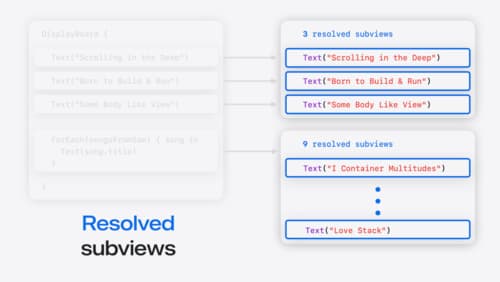CollectionView how to work
Asked on 2024-08-12
1 search
To work with a CollectionView in SwiftUI, you can use the List or ForEach views to iterate over a collection of data and create views for each element. This approach allows you to build complex UI structures by composing views. Here's a brief overview based on the content from the WWDC sessions:
-
List and ForEach: In SwiftUI, a
Listcan be initialized with a collection parameter, which is a convenience for creating aForEachview. TheForEachview generates views for each element in a collection and provides those to its container. This allows for creating advanced constructions, such as multiple collections of data organized into sections. You can customize lists using view modifiers, such as adding swipe actions to each row. This is discussed in the SwiftUI essentials session. -
Custom Views: You can create custom views that conform to the
Viewprotocol and have abodyproperty to return the view it represents. This enables compositional features and quick iteration. Custom views can be used like any other view and can have inputs that change how their body is created, allowing for reuse across different data sets. This is also covered in the SwiftUI essentials session. -
Sections: If you need to organize your data into sections, you can use the
Sectionview in SwiftUI. ASectionview behaves much like aGroupview but with extra section-specific metadata, such as optional headers and footers. This is explained in the Demystify SwiftUI containers session.
These sessions provide a comprehensive guide on how to effectively use collection views and related components in SwiftUI.

What’s new in SwiftData
SwiftData makes it easy to add persistence to your app with its expressive, declarative API. Learn about refinements to SwiftData, including compound uniqueness constraints, faster queries with #Index, queries in Xcode previews, and rich predicate expressions. Join us to explore how you can use all of these features to express richer models and improve performance in your app. To discover how to build a custom data store or use the history API in SwiftData, watch “Create a custom data store with SwiftData” and “Track model changes with SwiftData history”.

SwiftUI essentials
Join us on a tour of SwiftUI, Apple’s declarative user interface framework. Learn essential concepts for building apps in SwiftUI, like views, state variables, and layout. Discover the breadth of APIs for building fully featured experiences and crafting unique custom components. Whether you’re brand new to SwiftUI or an experienced developer, you’ll learn how to take advantage of what SwiftUI has to offer when building great apps.

Demystify SwiftUI containers
Learn about the capabilities of SwiftUI container views and build a mental model for how subviews are managed by their containers. Leverage new APIs to build your own custom containers, create modifiers to customize container content, and give your containers that extra polish that helps your apps stand out.
